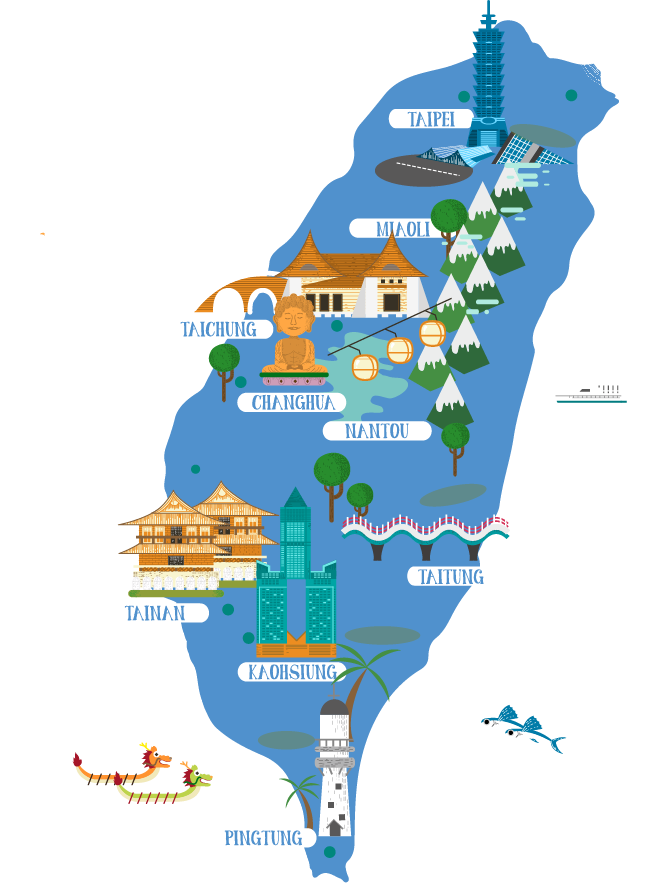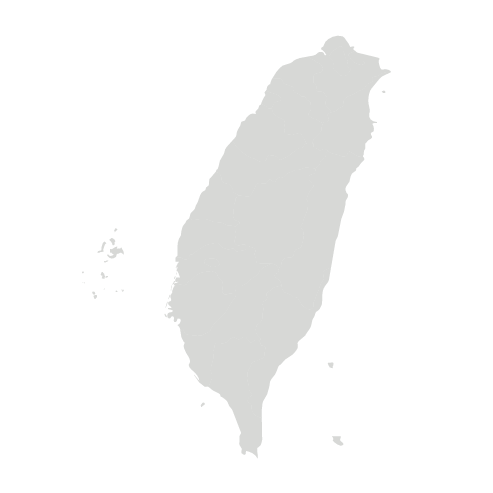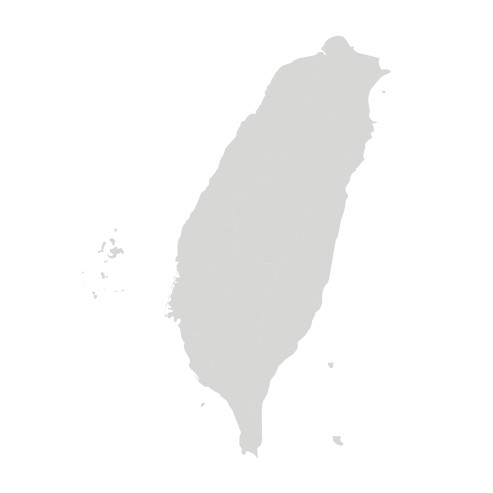36,200 km² in total
23.45 million inhabitants, putting Taiwan on the list of most densely populated islands in the world.
The island has mountains up to 4,000 metres in the east and extensive plains in the west, where most Taiwanese live.
Surrounded by Japan in the northeast, the Philippines to the south, and the Chinese mainland to the northwest.
Even the surrounding nations such as Japan and South Korea follow Taiwan’s example in upscaling their wind energy resources. Taiwan especially focuses on offshore wind capacity (an additional capacity of 5.7 GW, compared to 1.2 GW onshore by 2025), as available land area is limited, but also since there is a strong potential with a shallow coastline and powerful winds. These efforts could grant the island nation a top ten position in the world for wind power.
Jan De Nul supports Taiwan in its journey to carbon neutrality from the start by contributing to the development of four major offshore wind farms along the west coast of the island:
Climate change:
Taiwan is no exception
Frontrunner in wind power
Climate change is one of the biggest challenges facing the world today and it comes in many forms, affecting water, energy, transportation, wildlife, ecosystems and human health to name but a few. A rather small island like Taiwan also gets its share of the consequences of climate change.
In the last 100 years, the average temperature in Taiwan has risen 1.4° C, which is twice the worldwide temperature rise! This year, the island suffered the worst drought in more than half a century, followed by exceptional heavy rainfall. Both examples of the extreme weather events seen worldwide.
Taiwan is more than ever determined to turn the tide with a transition to renewable energy onshore and offshore.
Carbon neutral by 2050: more than 130 countries committed to this goal at the COP26 in November last year in Glasgow. Taiwan was at the forefront, despite the fact that it had to attend as a non-governmental delegation. The Taiwanese delegation managed to showcase the island's environmental ambitions and determination during one of the side events of COP26.





i
i
i

Located on the Tropic of Cancer, this island has a marine tropical climate.




Taiwan
Jan Kop
Project Director
“Taiwan with its typhoons, earthquakes and difficult soil conditions proved a stimulating challenge for all familiar with the industry.”

Joseph Yu
Environmental Engineer
“I met amazing people of different countries, full of passion and determination, always seeking solutions for every type of challenge.”


William Krijnen
Foundation and WTG Package Manager
“We learned a lot from our Taiwanese engineers, partners and subcontractors; as they did from us. Teamwork makes the dream work.”

Walking an ambitious renewable path
Taiwan prioritises the much-needed energy transition in its long-term plans, both on- and offshore. Important: the island nation does so without depending on other nations. To realise the shift in energy supply, Taiwan heavily invests in solar, biogas, geothermal, on- and offshore wind power.
This might not sound like a big deal, but the harsh geological and meteorological conditions make the installation of renewable energy resources, such as offshore wind farms, extremely challenging. So, when Taiwan set the ambitious targets to first achieve 5.7 GW of offshore wind energy capacity by 2025, and add another 15 GW in the ten-year period from 2026 to 2035, this implied next-to-impossible efforts. And when ‘impossible’ is part of the project description, Jan De Nul is all ears.
i

Jan De Nul mobilized 73 vessels and 19,000 employees from 18 different countries to manage these four offshore wind projects.
The strongest typhoon in recent memory was called Morakot. This Category 1-typhoon hit Taiwan in August 2009 with maximum speeds of 150 km/h and 2,777 mm of rainfall.







The last severe earthquake dates from 21 September 1999, called the 921 or Jiji earthquake with a magnitude of 7.3 on the Richter scale.



Looking for a partner to realize your net zero ambitions?
Contact our Head of Commercial Offshore Wind
Bart Willems

Rainy season
May and June
2,600 mm per year
June to October
Higher temperatures and more humidity in the atmosphere
Typhoon season


Earthquakes
Located on the border between the Philippine Sea Plate and the Eurasian Plate, the island is subject to many earthquakes throughout the year
The four offshore wind farms will produce a combined capacity of 1.5 GW providing electricity to 1.6 million Taiwanese households.



Calculating to withstand nature’s forces

PHASE 2


CHANGHUA

Taiwan's geographical, geological and climatic conditions have many challenges. Mainland China holds the title of the world's most earthquake-prone regions. Moreover, Taiwan has an exposed location in the northwest Pacific, a region known for its many typhoons. A situation that’s largely unknown in Europe.
At Jan De Nul, we have risen to that challenge. Engineers of our Design and Engineering Department immersed themselves in the subject. The prognoses for earthquakes and typhoons in the region and their impact on offshore structures were included in project calculations. Today, we have a backpack full of knowledge that we now apply to current and future developments in the region.
Foundations
The jacket foundations are designed to withstand cyclonic waves and winds, and earthquake loads.
Working together with local fishermen
Blades
A special feature of the TPC turbines is the downwind configuration of the blades: wind loading is reduced by keeping the rotor oriented in such a way that it is not subjected to crosswinds, even during shutdown.
Turbines
All wind turbines deployed in this region are certified as Typhoon-Resistant (T-Class).
“We had to cross a 1 kilometre-long sand bank, a tidal river and a 500 metre-wide oyster farm area. Unknown terrain for us, so we contacted the local oyster farmers and fishermen. They taught us about the soil conditions, helping us and our vehicles to reach the work site in a safe and efficient way. Their knowledge was key to the success of the cable works. In return, we involved them in the project’s progress and helped them to observe local marine life.”
Mathieu Wittouck, Subsea Cables Package Manager
Taiwan is known for its shallow coastline. A perfect environment to install offshore wind power, but a challenge for Jan De Nul’s cable installation teams. The working area was barely accessible due to the shallow water more than 3 km away from the shore.


Looking for a partner to realize your net zero ambitions?
Contact our Head of Commercial Offshore Wind
Bart Willems

Located on the Tropic of Cancer, this island has a marine tropical climate.

Rainy season
May and June
2,600 mm per year
June to October
Higher temperatures and more humidity in the atmosphere
Typhoon season


Earthquakes
Located on the border between the Philippine Sea Plate and the Eurasian Plate, the island is subject to many earthquakes throughout the year


The strongest typhoon in recent memory was called Morakot. This Category 1-typhoon hit Taiwan in August 2009 with maximum speeds of 150 km/h and 2,777 mm of rainfall.
The last severe earthquake dates from 21 September 1999, called the 921 or Jiji earthquake with a magnitude of 7.3 on the Richter scale.
Climate change:
Taiwan is no exception
Climate change is one of the biggest challenges facing the world today and it comes in many forms, affecting water, energy, transportation, wildlife, ecosystems and human health to name but a few. A rather small island like Taiwan also gets its share of the consequences of climate change.
In the last 100 years, the average temperature in Taiwan has risen 1.4° C, which is twice the worldwide temperature rise! This year, the island suffered the worst drought in more than half a century, followed by exceptional heavy rainfall. Both examples of the extreme weather events seen worldwide.
Taiwan is more than ever determined to turn the tide with a transition to renewable energy onshore and offshore.



CHANGHUA

Carbon neutral by 2050: more than 130 countries committed to this goal at the COP26 in November last year in Glasgow. Taiwan was at the forefront, despite the fact that it had to attend as a non-governmental delegation. The Taiwanese delegation managed to showcase the island's environmental ambitions and determination during one of the side events of COP26.


Walking an ambitious renewable path
Taiwan prioritises the much-needed energy transition in its long-term plans, both on- and offshore. Important: the island nation does so without depending on other nations. To realise the shift in energy supply, Taiwan heavily invests in solar, biogas, geothermal, on- and offshore wind power.
This might not sound like a big deal, but the harsh geological and meteorological conditions make the installation of renewable energy resources, such as offshore wind farms, extremely challenging. So, when Taiwan set the ambitious targets to first achieve 5.7 GW of offshore wind energy capacity by 2025, and add another 15 GW in the ten-year period from 2026 to 2035, this implied next-to-impossible efforts. And when ‘impossible’ is part of the project description, Jan De Nul is all ears.
Taiwan
36,200 km² in total
23.45 million inhabitants, putting Taiwan on the list of most densely populated islands in the world.
The island has mountains up to 4,000 metres in the east and extensive plains in the west, where most Taiwanese live.
Surrounded by Japan in the northeast, the Philippines to the south, and the Chinese mainland to the northwest.




Even the surrounding nations such as Japan and South Korea follow Taiwan’s example in upscaling their wind energy resources. Taiwan especially focuses on offshore wind capacity (an additional capacity of 5.7 GW, compared to 1.2 GW onshore by 2025), as available land area is limited, but also since there is a strong potential with a shallow coastline and powerful winds. These efforts could grant the island nation a top ten position in the world for wind power.
Jan De Nul supports Taiwan in its journey to carbon neutrality from the start by contributing to the development of four major offshore wind farms along the west coast of the island:

i
“We had to cross a 1 kilometre-long sand bank, a tidal river and a 500 metre-wide oyster farm area. Unknown terrain for us, so we contacted the local oyster farmers and fishermen. They taught us about the soil conditions, helping us and our vehicles to reach the work site in a safe and efficient way. Their knowledge was key to the success of the cable works. In return, we involved them in the project’s progress and helped them to observe local marine life.”
Working together with local fishermen
Taiwan is known for its shallow coastline. A perfect environment to install offshore wind power, but a challenge for Jan De Nul’s cable installation teams. The working area was barely accessible due to the shallow water more than 3 km away from the shore.


Mathieu Wittouck,
Subsea Cables Package Manager
Foundations
The jacket foundations are designed to withstand cyclonic waves and winds, and earthquake loads.

William Krijnen
Foundation and WTG Package Manager
“We learned a lot from our Taiwanese engineers, partners and subcontractors; as they did from us. Teamwork makes the dream work.”
Joseph Yu
Environmental Engineer
“I met amazing people of different countries, full of passion and determination, always seeking solutions for every type of challenge.”

Jan Kop
Project Director
“Taiwan with its typhoons, earthquakes and difficult soil conditions proved a stimulating challenge for all familiar with the industry.”

i
i
i
Turbines
All wind turbines deployed in this region are certified as Typhoon-Resistant (T-Class).
PHASE 2

Jan De Nul mobilized 73 vessels and 19,000 employees from 18 different countries to manage these four offshore wind projects.






The four offshore wind farms will produce a combined capacity of 1.5 GW providing electricity to 1.6 million Taiwanese households.

Blades
A special feature of the TPC turbines is the downwind configuration of the blades: wind loading is reduced by keeping the rotor oriented in such a way that it is not subjected to crosswinds, even during shutdown.



Calculating to withstand nature’s forces
Taiwan's geographical, geological and climatic conditions have many challenges. Its neighbouring country China holds the title of the world's most earthquake-prone regions. Moreover, Taiwan has an exposed location in the northwest Pacific, a region known for its many typhoons. A situation that’s largely unknown in Europe.
At Jan De Nul, we have risen to that challenge. Engineers of our Design and Engineering Department immersed themselves in the subject. The prognoses for earthquakes and typhoons in the region and their impact on offshore structures were included in project calculations. Today, we have a backpack full of knowledge that we now apply to current and future developments in the region.










